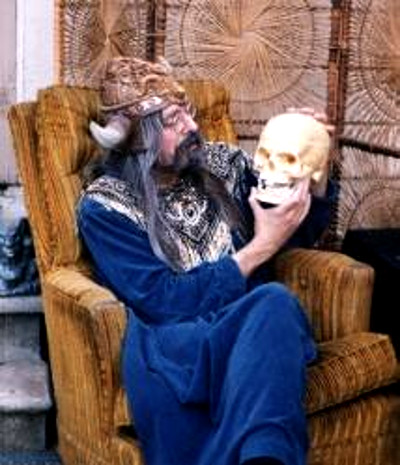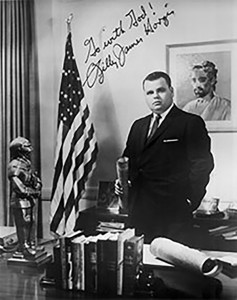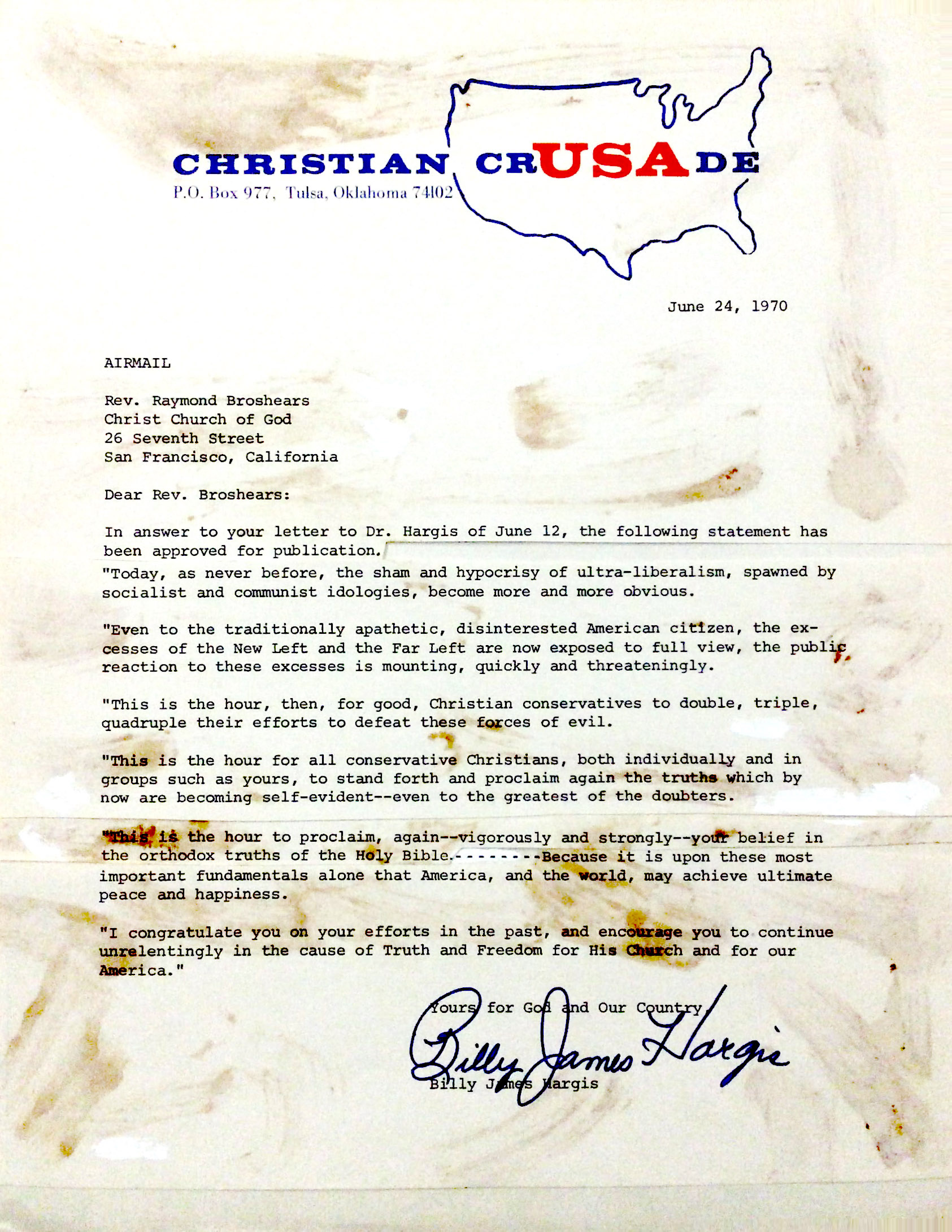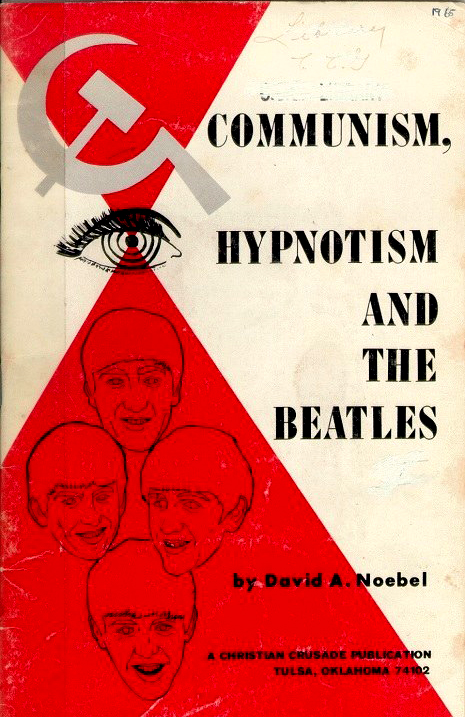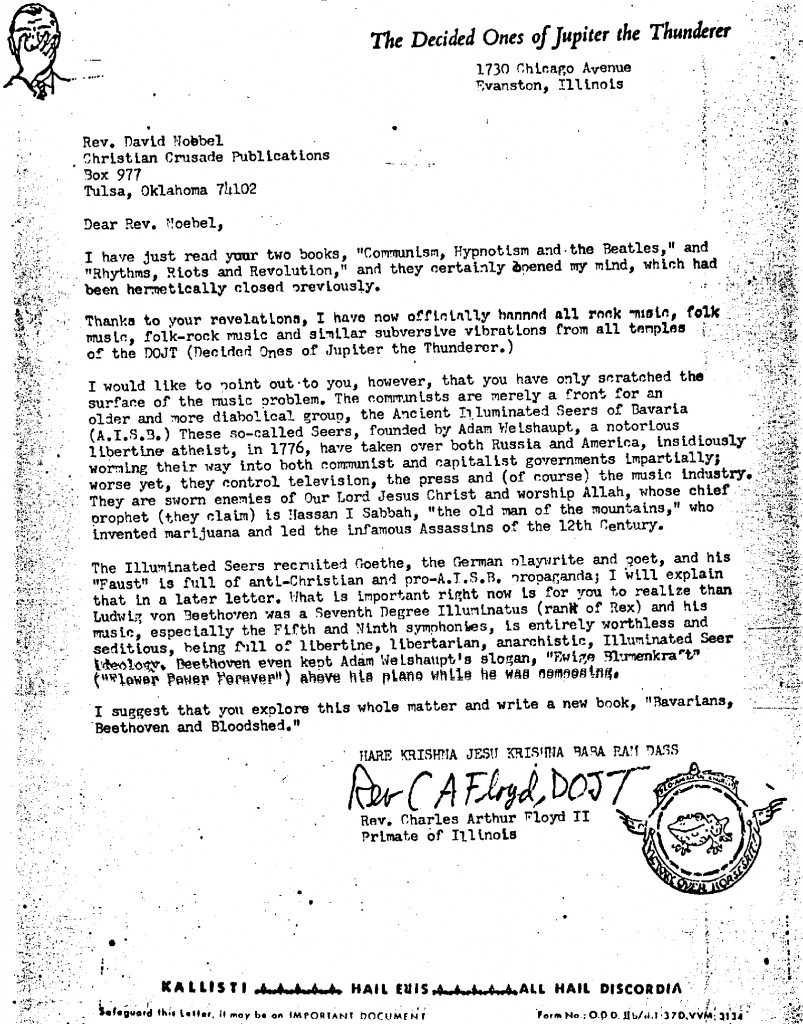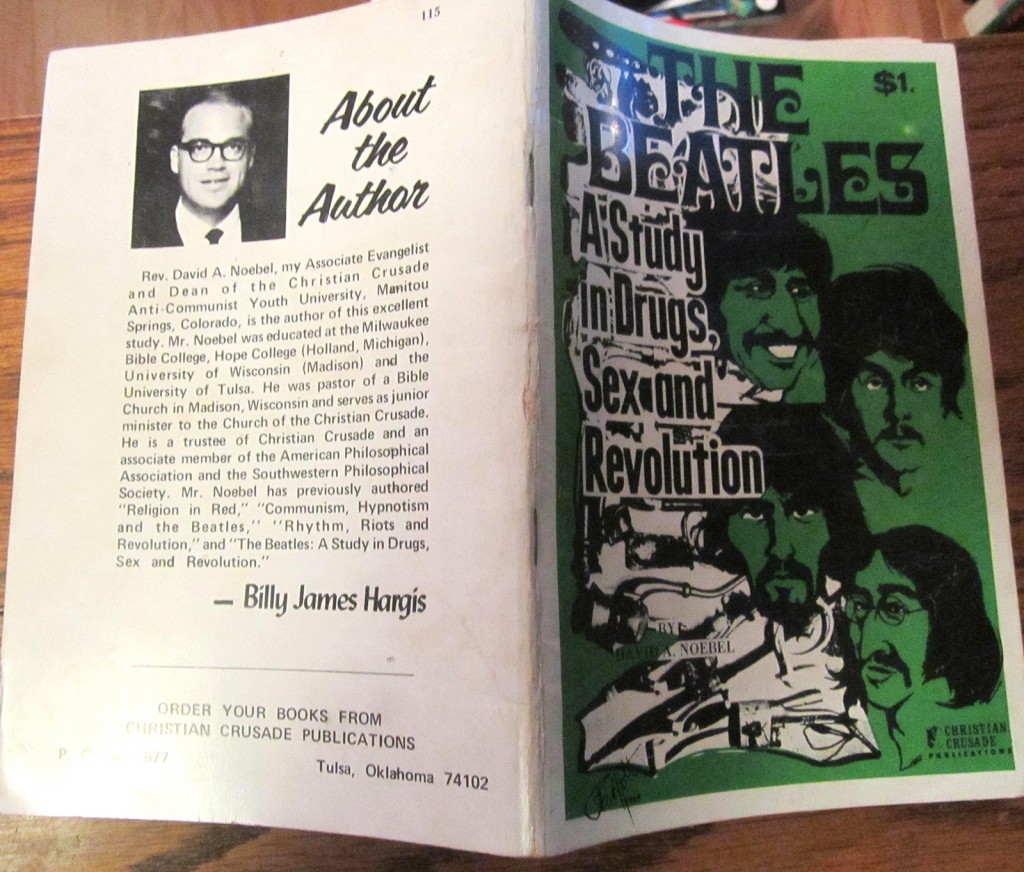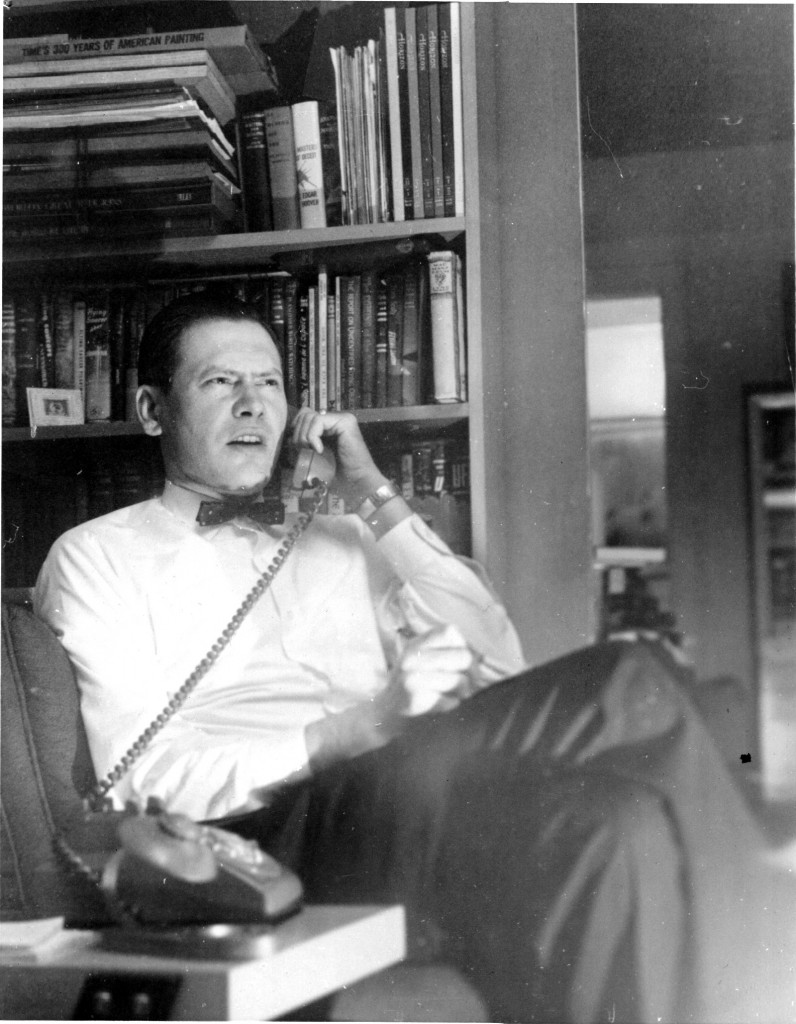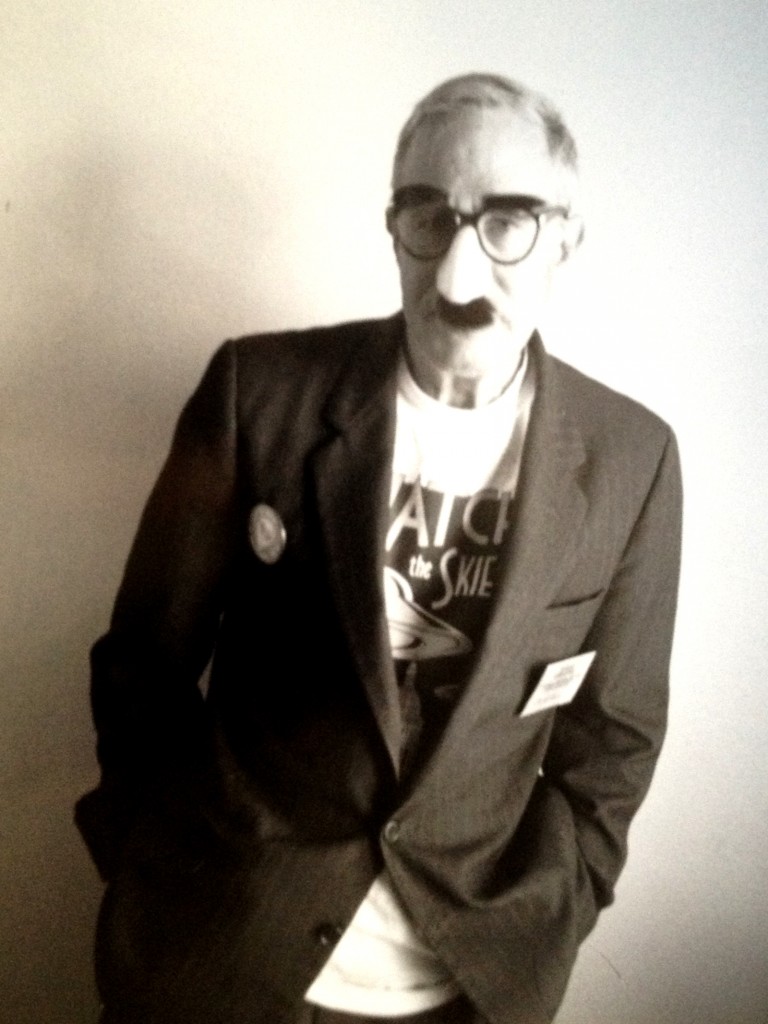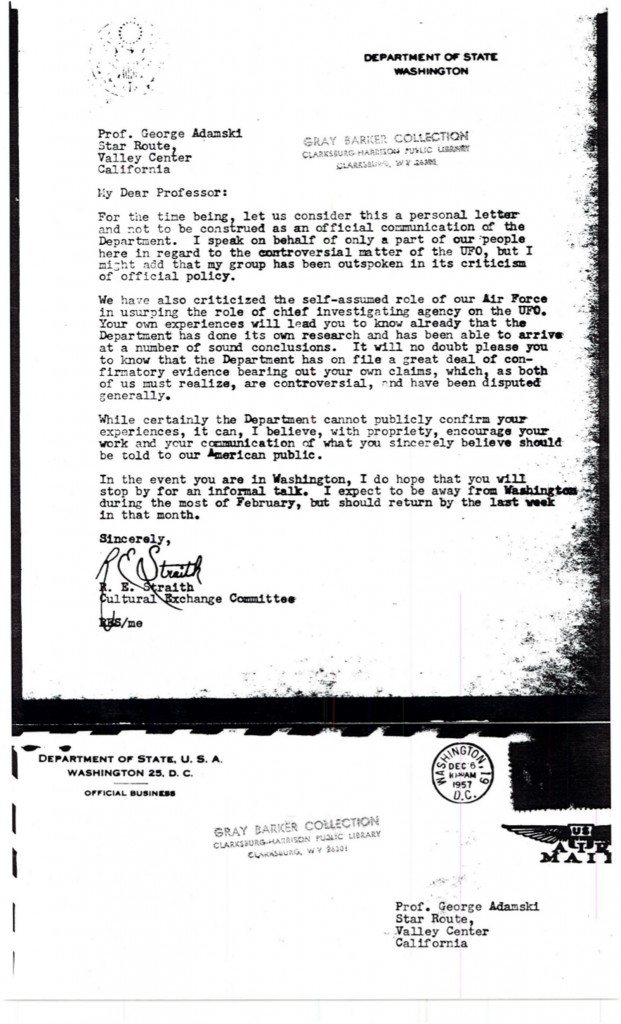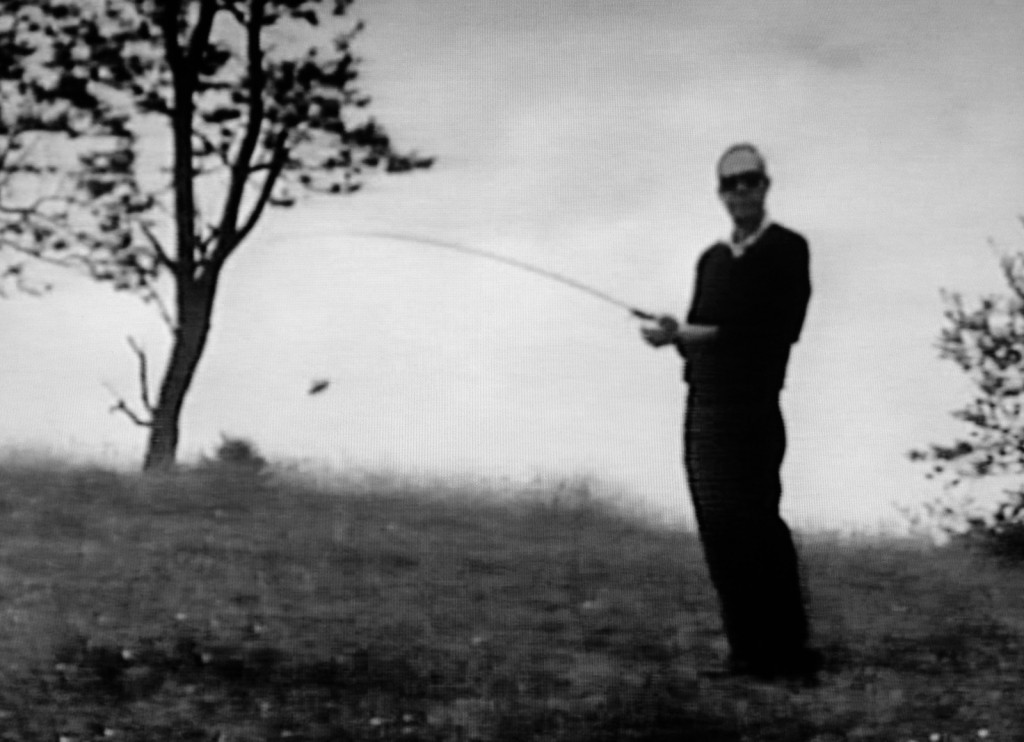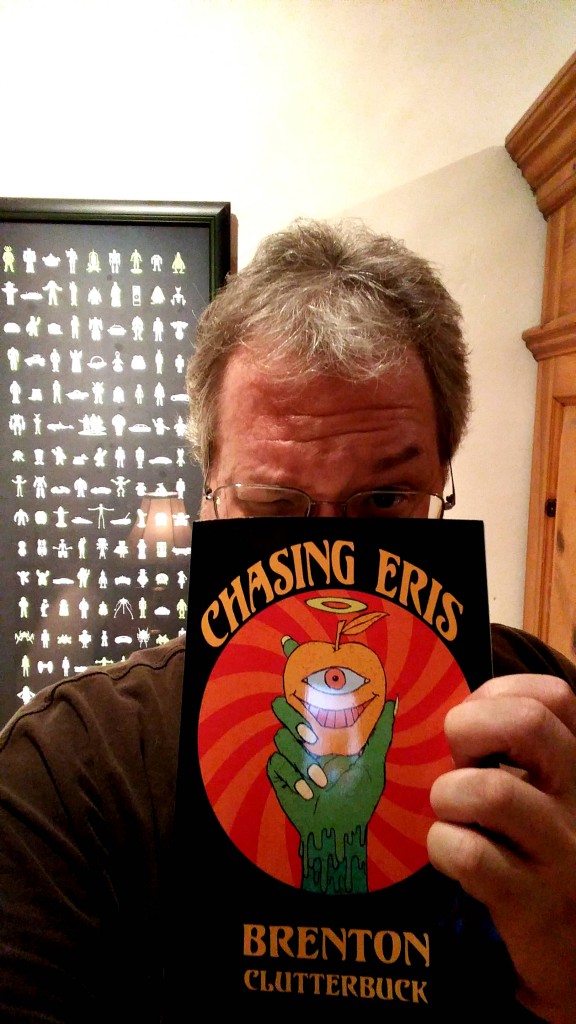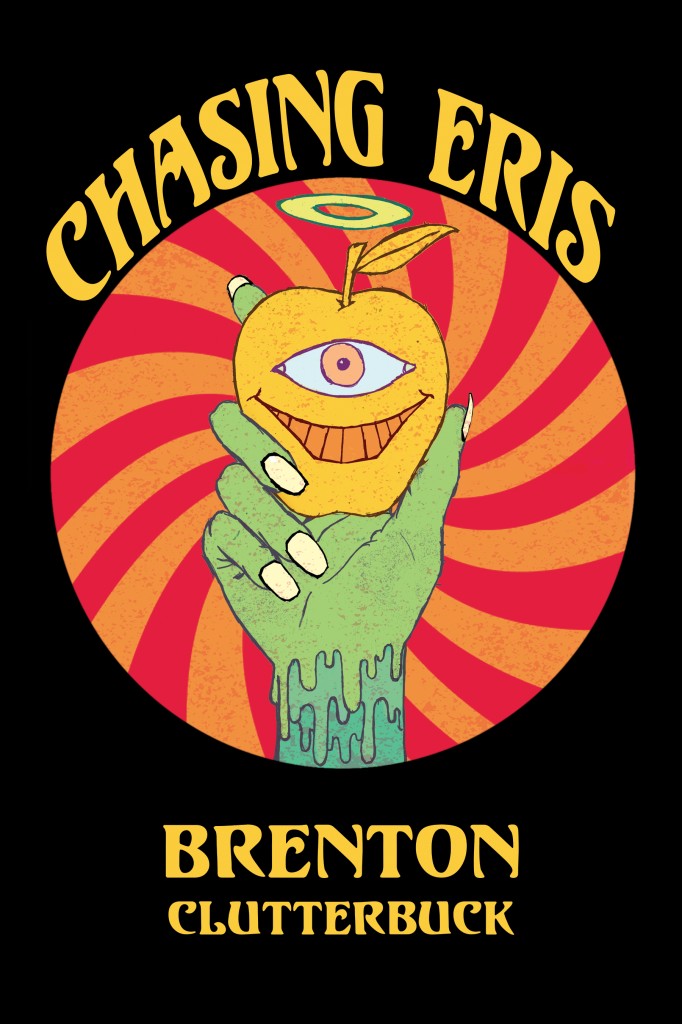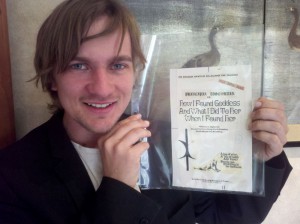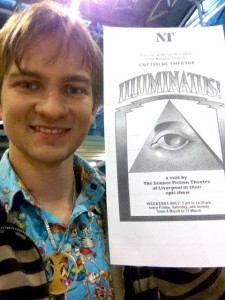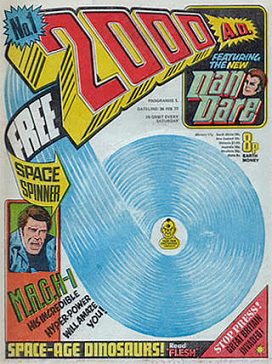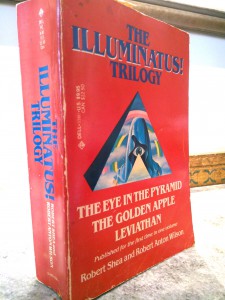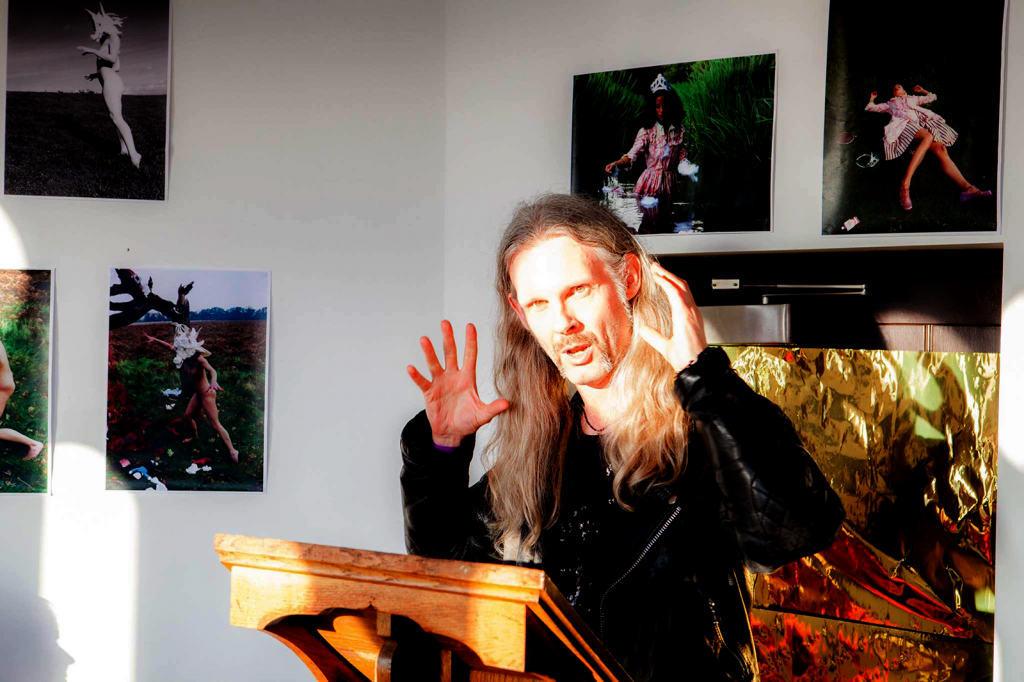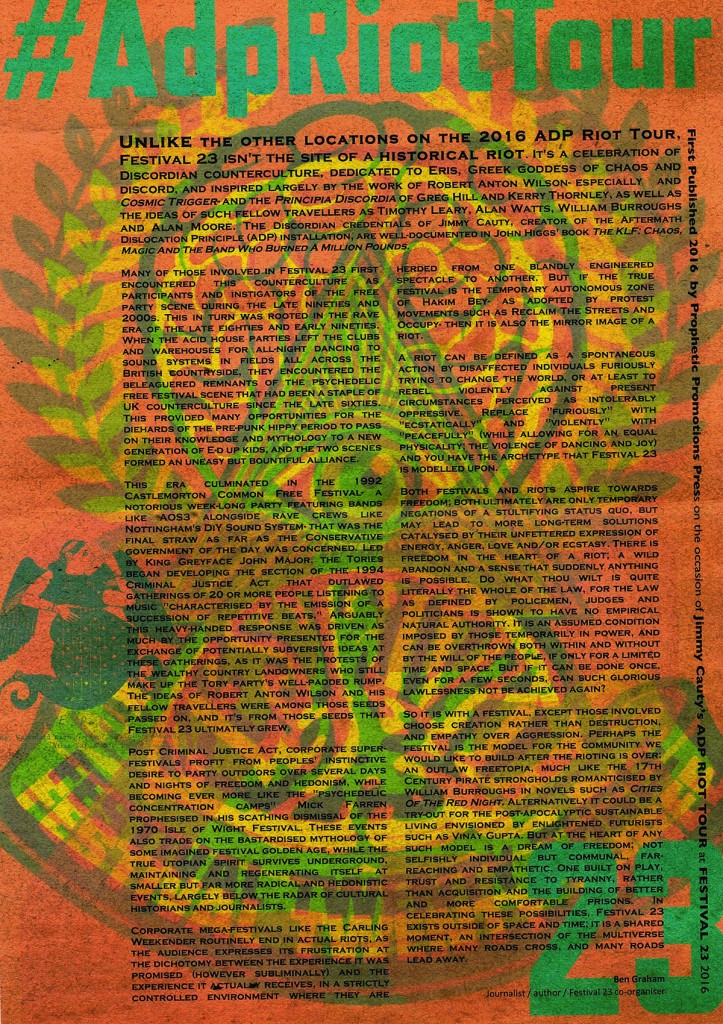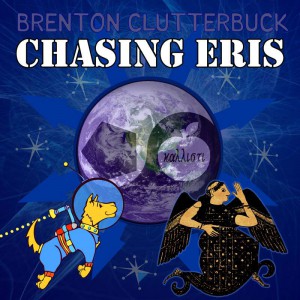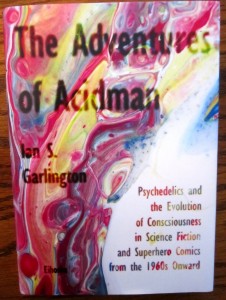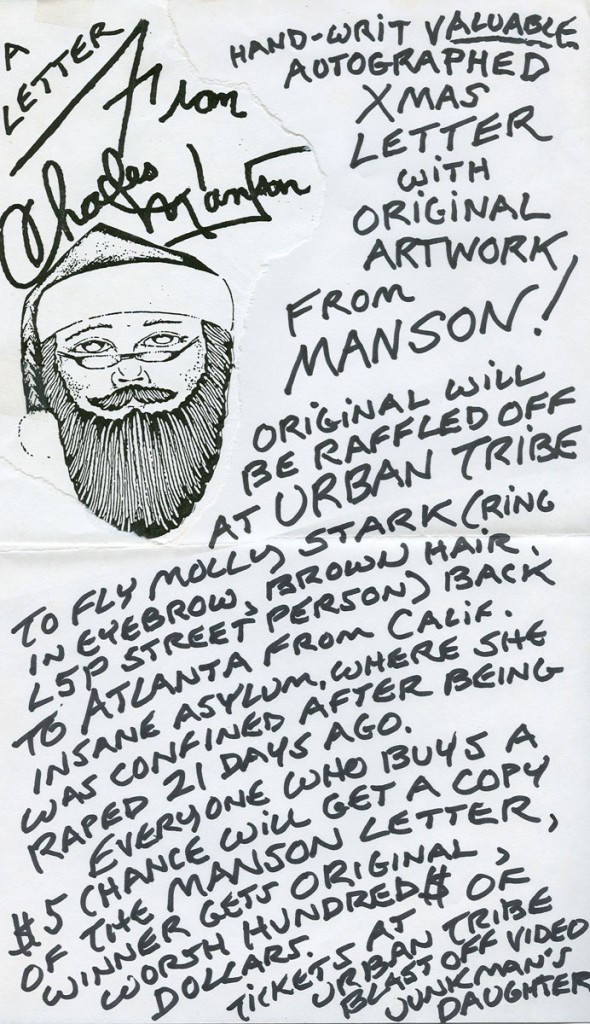The opinions expressed in this article are solely those of the author, although the command staff here at Historia Discordia has no reason to doubt the central thesis presented herein, based–as it is–on evidentiary documentation referenced by Mr. Clutterbuck, not to mention his own personal journey down the sock-puppet filled Rev. Loveshade rabbit hole. – The MGT.
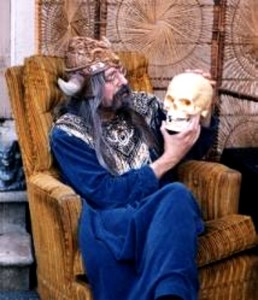
Binky The Wonderskull.
The order of the Pineapple was first presented in 1982 by the Ek-Sen-Trik-Uh Cluborguild. Except it wasn’t – which is the problem. It wasn’t invented in ’82, more likely it was invented in 2015. And many of the recipients – Spears, Hilde, Skripto, Unicornia etc – are entirely fictional.
This is just one symptom of the problem that lives very, very deep in current day Discordianism. It is the problem of Reverend Loveshade.
How do you write the history of a serial liar? It doesn’t make sense to simply assemble their lies and present them. Loveshade is a difficult liar because he is a Discordian liar – he is always winking at the camera. Many of the claims he makes are tongue in cheek and ridiculous, but there are certain ‘facts’ that are presented repeatedly. For instance, Loveshade’s involvement in adult film when younger, or his commune, or his persecution by the government—all are consistent moments referenced both seriously and playfully in different places. But why bother? If we can trust anything about Loveshade, it’s that we can rely on him to be a liar.
Loveshade appears to be a member of a large and eclectic community of Discordians, whose brand of Discordianism is liberty driven, owing much to the free love movements of the hippie scene. The community involves a number of young, often related young girls, including some of the above recipients of the Order of the Pineapple. There’s the Spears clan, the Black family, and the Loveshades, and a sprinkling of outsiders. Interactions between what we might call ‘the Loveshade family’ and others tend to be fraught with tension; some on philosophical grounds, some because I can tell you from experience that Loveshade’s adventures in forums and comment sections can be a tad antagonistic, and some because he likes to namedrop.
We can trace Loveshade’s internet history back to somewhere between 1998 and 2000. Loveshade’s mythology often references a bygone figure called Bloodstar/Alien Loveshade. Bloodstar appears real (in some sense), a figure on Geocities around the turn of the millennium. Bloodstar had some interactions with another Geocities user, A.D. Lea.
Between the two, the evolution of the Loveshade family can be seen. Both websites (Bloodstar and Alien Loveshade) have a fixation on copyright and image use that resembles current Loveshade family pages. Both pages pay tribute (including photos) to a model skull referred to as Binky the Wonderskull. Both pages link to the five key beliefs and other writings of Loveshade. A.D. Lea writes about gender in a passage called Gender Genesis – this is now on ‘Alden Loveshade’s’ page, attributed to him.
A.D. Lea also has photos of a Halloween party, some of which appear now on pages run by Alden Loveshade. This involved a kind of spooky tour, with pictures of wizards, wackos and wolfmen. The aforementioned ‘wacko’ is a bearded cleaver wielding maniac named Dr Sinister Craven. The man in that picture will come up again soon. The ‘Wizard’ is also later referenced as ‘The Wizard Lea’. It is a picture many will recognise as the self-portrait of Alden Loveshade. Most pictures are copyright A.D. Lea, but this one is attributed to another person called Dan, who will also come up again.
Bloodstar has another classic Loveshade attribute; he puts forward an interest in nudism, linking to several pages. Those pages often have a focus on selling images of ‘family nudity’. He also shares a ‘self-portrait’–a photoshopped floating head with exaggerated facial hair. The unedited image is commonly used as a self-portrait by Alden Loveshade.
Both A.D. Lea and Bloodstar link to Loveshade’s page at different times, often with the suggestion that it is coming soon – both linked to the Loveshade page as a work in progress. In fact, Bloodstar may even have alluded to creating Reverend Loveshade in his 1998 end of year letter (a tradition Alden Loveshade continues) – I established a Secret Earth Identity this year. I can’t talk about that too much, either.
We can assume A.D Lea and Bloodstar/Alien Loveshade are the same, and that they’re both Reverend Loveshade.
It wouldn’t quite be a Discordian story without dramatic jumps through space and time, but I feel this is a good time to talk about ‘The Biography of Alden Loveshade’ because I will be making references to it from here on, and I want to give credit where due.
The current Loveshade preoccupation of Wiki editing has not made Loveshade (or his ostensible community members ‘Pope Hilde’ and ‘Miley Spears’) many friends. In the SubGenius community in particular, there has been push-back against Miley Spears’ hostile takeover of the Subgenius Fandom Wikia. I’m unclear of the specific details, but around two years ago some members did some digging into Loveshade, and made a host of accusations, and were told to come back with proof.
They did. This PDF documents Loveshade’s court records from 2002 and identifies a few things about those early Geocities pages that I hadn’t spotted — in particular, his use of meta descriptions that seem designed to attract a… questionable community of fans.
“…closer inspection of the HTML shows a trend that becomes all too frequent in Loveshade-related online materials. Meta Descriptions, such as those seen in the screenshot below, containing tags like, ‘pregnant, pics, children, preteens, teenagers,’ and so on.”
I stumbled across this PDF through a series of leads, each more tenuous than the last. This lead—a guy I’d seen fall out with Loveshade on Facebook—was deeply paranoid of me when I introduced myself. Even after I sent a video of myself, clearly stating my name, it didn’t stop his suspicions that I was–or was affiliated with–Loveshade. I have to say, I don’t blame him.
In the end though, he was kind enough to decide to trust me. His name was M. Otis Beard, and he was himself an internet celebrity of a kind, a member of the Ur-Internet Troll association of ‘Kibologists’, and in particular had become a kind of unofficial spokesperson for faking your own death on the internet, something he did in 1999. Beard mentioned ‘the PDF’ offhand, assuming I knew of it, before directing me to a Subgenius group where I could find it.
Around this same time, I received an email from another individual, stating simply:
Heard your asking about Loveshade. I can tell you shit.
This was followed by a completely different document with an aesthetically similar cover. However the title was ‘The Biography of Reverend Loveshade’, and the content was wildly different. Without going into full details, there’s a simple reason for this; the person who sent it to me is Reverend Loveshade and he’s trying to muddy the waters, so that the reaction to the Subgenius document is the same as the current reaction to the whole of the Loveshade saga– ‘this is a weird mess, so I’m just not going to think too hard about it.’ In total, the moral of this second document is as follows – the man you think is Loveshade is framed, the real Loveshade is another person, and all his sock-puppets are real, too.
Like I said, I don’t blame Beard for his paranoia.
The first notable instances of Loveshade interacting with other Discordians is on a Yahoo group called Illuminatusinnersanctum. His first post is in July of 2001, and he speaks of being invited by user ‘Chezire_Katt’, who seems to have performed several membership runs to gather new users. His last is in 2012, by which point the forum was basically a wasteland of spambots.
This puts Loveshade as a participating member of Illuminatusinnersanctum forum at the time of his reported 2002 arrest by Texas Law Enforecement officials, which allows us to put together a timeline. Further details can be found in the PDF.
On March 19, 2002, Loveshade posts his last message on the Illuminatusinnersanctum forum, after being an incredibly active poster.
‘The Biography of Alden Loveshade’ lists March 29, 2002 as Loveshade’s arrest.
On May 13, 2002, Chezire_Katt mentions that they wonder where Loveshade is.
On Feb 14, 2003, George_W._Bust (could be Loveshade out on bail, or a friend) writes the following message:
Somebody brought up an old message of Reverend Loveshades so I thought I’d better comment.
For those who dont remember him, he used to be a frequent poster here. That was until he was investigated by the FBI and the Secret
Service and arrested on an imaginary charge. He’s currently being held in solitary confinement.He’s been threatened many times with arrest because of his fights for freedom. Now that fundamental American freedoms are being
threatened in the name of security, we are all vulnerable.His writings can be found on many web sites. Please read the first one below at least. It has suggestions for what you can do. Don’t bother emailing him now. He has no way to respond.
http://www.geocities.com/bloodstar84/stripfreedom.html
http://www.geocities.com/Area51/Zone/7971/panpleasant/apocrypha.html
http://www.neuroatomic.com/stealthisWe are hopeful that the Rev will soon be released. Remember his words when he said:
“Don’t wait for your grandchildren to ask you why you watched fundamental American freedoms being stripped away and did nothing.”
Loveshade’s sentencing date is April 12, 2003.
Suddenly, on October the 18th, 2005, Loveshade reappears:
As Mark Twain once said, “The reports of my death are greatly exaggerated.”Yes, Ladies and Gentlemen, I’m back!
I’d like to clarify several things, but I won’t because other people are involved and everything is yet to be resolved. And frankly, I’m still a little scared myself (for a while, I was scared as hell). A lot of what I write is B.S., but the rest of this is as true as I can make it.
I and some of my associates were a part of a national investigation in the U.S.A. which may have extended internationally, we aren’t sure. This began not too long after Sept. 11, 2001. Part of that investigation, and perhaps only a small part, was an attempt to learn the true identity of the Discordian “BloodStar,” who still remains in “hiding,” and of “Reverend Loveshade.”
As I have no reason to want to pin down my “true” identity, I’ll leave it at this:
* we were investigated for a number of “crimes,” many having to do with freedom of speech. As one of our group is on the edge of having the last charge dismissed, I don’t want to go into details
* there were almost certainly bugs planted, and informants for government agencies planted as well (some of this was well done, and some was so clumsily handled as to be almost laughable)
* one of us was held for months in solitary confinement
* several of us were threatened by citizens/government agencies/police officers
* there were several searches conducted in various parts of the U.S.A.
* the work (writings, photos, etc.) of many of us were seized (including writings of some people who posted to this site, some of whom are likely still unaware of the investigations)
* at least two people who posted to this site were questioned in person by the authorities (we suspect more)
* at least a dozen agencies in the U.S.A. were involved in the investigation, including the FBI (we don’t have official documentation that the Secret Service was involved, and at this point their involvement seems doubtful. But an attorney said it appeared quite probable that a then-prominent person in the federal
government was our “enemy”)
* not a single agency found a single thing that agency identified as being illegal–except for a small-town police department. (Note that the “evidence” from this local cop was turned over to various agencies including the FBI, which had it for almost a year–after that cop held it for two years–before admitting they found nothing illegal).As to posting “jokes” about Sept. 11, some of the postings almost certainly were a part of the investigation. Fortunately, some investigators had enough brains to realize the postings were jokes before more people who posted here were questioned.
Be careful what you kid about in a public forum; be careful what you take photos of (you never know what contemporary community standards are out there); be careful what you write in fiction that someone might think is true; and be careful claiming that the government is a bigger threat to freedom than terrorists–especially if they are.
Reverend Loveshade
discordia.loveshade.org
So the timeline is consistent. Loveshade was investigated, arrested, found guilty, went to jail, and came out again, to resume his online Discordian career where he left off.
One oft repeated piece of mythology is a variation of this: ‘Loveshade married a 15 year old girl to three grooms and everyone was naked.’ The truth of that matter is that a bunch of people had a goofy conversation in chat in November 2001. Loveshade has tendency to exaggerate the innocuous and downplay the serious. But there’s some things to note. One is that one of the three grooms, Danacasso, is known to Alden in the real world. Remember the Wizard photo? On his website, Alden attributes it to the photographer’s real name; on Facebook he attributes it to Danacasso. I contacted Danacasso, but received no reply.
Not so notable, but interesting to see, are Loveshade’s interactions with Shereed Volva on Illuminatusinnersanctum. There’s no speculation here – Shereed Volva, the editor of an edition of Discordian Open Source periodical ‘Intermittens’ outed himself as Loveshade, and gleefully pointed out that his name was an anagram for Reverend Loveshade. So when you see Volva and Loveshade interact remember – this is a man conversing with his own sockpuppet account.
One of Loveshade’s goals, in both Discordianism and Church of the Subgenius, is to rewrite the history of both to his liking. There’s a few tools he’s used to achieve these ends. The absolute control of basically all Discordian and SubGenius wikis is one. (The simplicity of this is almost admirable. Disused wikis lie around everywhere, waiting to be infiltrated with a sock army.) Another is presenting things as rumour from a sockpuppet, followed by a kind of smirking not-quite-denial from Loveshade. This is the method he’s used to suggest that he may be the child of Robert Anton Wilson’s murdered child Luna Wilson (it goes without saying, but no). And the final, most ambitious, is the wholesale construction of historical figures.
Richard Marshall. Gypsie Skripto. Mike Quinn ‘The MGT’. All historical figures. All bullshit.
Here’s the rule for working out if it’s a Loveshade sockpuppet. Can you draw lines between one verified human and another? If not, it’s a puppet. And the same is true of these ‘historical figures.’ There’s no evidence for Gypsie’s existence, outside of being a construction of Greg Hill in the 4th Edition afterword of the Principia Discordia. There’s no evidence of Mike Quinn/The MGT existing outside of the character created by Robert Anton Wilson. And the proof of Richard Marshall is that an obituary exists for a James Richard Marshall… but the links to Discordians? Nada.
One strategy Loveshade used to create these characters is through the purchase of the website kerrythornley.com, run under the pseudonym ‘Johnny Shellburn’ (the protagonist from Kerry Thornley’s Idle Warriors). Apart from all of the other painfully obvious clues I managed to avoid seeing at the time, I realised this connection when interviewing Shellburn for my book Chasing Eris, and my email bounced, delivering this message:
Your mail message to the following address(es) could not be delivered. This is a permanent error. Please verify the addresses and try again. If you are still having difficulty sending mail to these addresses, please contact
Customer Support at 480-624-2500.<domains@loveshade.org>:
68.142.202.129 failed after I sent the message.
Remote host said: 554 Message not allowed – [PH01] Email not accepted for policy reasons. Please visit http://postmaster.yahoo.com/errors/postmaster-27.html [120]
The site exists to put ‘Shellburn’ in contact with seekers who he can baffle with bullshit. It also exists to muddy the waters of fact and fiction. Sondra London’s entirely credible interview with Kerry Thornley sits beside Richard Marshall’s fake interview with ‘Pope Hilde’. Possibly credible letters from Thornley sit alongside Thornley’s ‘Order of the Pineapple award.’
A few years ago, in a moment of astonishingly bad judgement, I agreed to do an interview with ‘Alden Loveshade’ for Yahoo News. (At the time, I regarded Reverend Loveshade as simply a troll, and Alden Loveshade as a separate person.) That news story never happened, and Alden instead, under the name ‘Johnny Shellburn,’ used my interview in his history-rewriting edition of Intermittens. In particular, he contrasted my entirely true allegations that ‘Gypsie Skripto’ and ‘Richard Marshall’ are bullshit, against his own evidence that they existed. It’s not enough for Loveshade to be able to make his own sandcastles in the sandpit – anyone who points out that the castles are made from sand must be punished.
Here’s another one: Reverend Loveshade developed a strong disagreement with a latter day Discordian who I refer to in my book Chasing Eris by the name ‘Smith’. Loveshade chased Smith around with a series of sock-puppets, and when Smith insulted Miley Spears, Loveshade looked up Smith’s address and mailed him cease and desist letter to demand a retraction for Smith’s supposedly defamatory statements. Then, in another scheme using sock-puppets, Loveshade tried to further entangle Smith into his web by posting in multiple places a lengthy conspiracy theory that he and Smith were the same person.
While googling Chasing Eris one day (vanity, darling), I discovered a website I hadn’t created called chasingeris.com. It had a decidedly Loveshadian look to it. Panicking, I contacted the webmaster to request they state clearly that they had no official connection to me, and to my great surprise they offered to transfer me the site. Phew! The owner then made a massive song and dance about how their name was a secret.
Now we’ll ask you a big favor. For me to do the transfer and for you to pay $30 into my paypal account, I’ll have to give you my real name. PLEASE don’t give this out. When you see my name, you may understand why. Or not.
Who am I.
Their first name was one that Loveshade commonly claims is his real name. Their surname was Smith’s real-life surname. I believe Loveshade was leaving breadcrumbs towards the theory that he and Smith were somehow connected. In fact, many of his schemes seem based on leaving little clues for internet detectives, surnames, anagrams, numbers, etc. It must be hard to be a big-brain genius that nobody appreciates.
Remember the trick to telling a human from a sock-puppet? A line between one flesh and blood human to another? I’ve only seen this twice – One between Alden and Daniel/Danacasso. The other is Alden and Doctor Sinister Craven.
Remember that Halloween party where many of Loveshade’s pictures come from? There’s a man with an evil grin and a meat-cleaver. He is the only person on that page that I’ve seen reappear over and over. He uses his real name, not Craven, however I won’t repeat it here. You’ve seen it though if you’ve viewed Loveshades’ blog – one clueless real human making comments in a sea of sock-puppets.
I bring up Craven because of what I’ve seen on his Facebook page. He writes a lot of poetry for Melissa Spears who is perhaps catfishing him, and has had disagreements online with members of the Loveshade clan. Craven posts online to say that his psychologist is telling him there is no such person as Melissa Spears, and Loveshade alts rush to contradict him. Alden warns Craven that MU Spears, who is defending Melissa’s honour, is a trained killer from the military. Bob Black scoffs at Craven, saying MU Spears could break his arm with his little finger. Of course, the Blacks, the Spears, the Loveshades; they’re all Alden.
Craven is not well, and Loveshade is using his army of sock-puppets to harass, threaten, gas-light and perhaps cat-fish him all at the same time.
By far the most creeped out I felt in the great Loveshade atrocity exhibition was in perusing the diary of Lorien Loveshade aka Princess Unicornia (but really, again, who cares – they’re all one person). Lorien’s diary, incidentally, is where scepticism about Loveshade’s sock-puppet army goes to die. Forget the ice-bucket challenge, forget the bird-box challenge, it’s time for the Loveshade challenge.
1. Spend 5 – 10 minutes perusing Lorien Loveshade’s page.
2. Look somebody in the eyes.
3. Repeat these words; “It’s totally plausible that this is the website of a 30 year old woman with a career in education.”
You just can’t do it.
The ‘Biography of Alden Loveshade’ covers this page quite well:
Lorien Loveshade is a webpage which began in 2005, presenting itself as that of an 18-year-old girl’s online diary, sharing intimate details of her life from pre pubescences forward, while simultaneously being heavily steeped in discussions of a sexual nature–Essentially erotic fiction geared towards pedophiles.
But this only gives a rough outline of the whole thing, and while I don’t want to be grotesque for the sake of it, I do want to give a sense of what’s there.
The diary entries are divided into three sections – preteen, teen and adult.
These diary entries include two preteen stories that are deeply uncomfortable to read. One is of a ten year old Lorien having her first tongue kiss while having her bottom fondled. Another is of a young Lorien having a fun day on the internet playing on chat with a stranger encouraging her and her friend to strip and touch each other (fortunately, that is not what happens).
There’s a narrative at play here. Compare to the story behind Miley Spears, or some of Lorien’s more vivacious friends. Lorien has been fondled, tongue kissed, exposed to internet perverts, visited the set of a porn shoot, and as a result? Has remained pure and virginal well past the legal age of consent. Miley Spears however was protected by her parents from sex, and as a result, had sex very early. Not only does exposure to sex apparently not harm a child, it actually is really good for them!
We don’t need to guess at this worldview – ‘Lorien’ spells it out for us in an article tastefully titled ‘Teen Sex.’
“One of my best friends was raised extremely strictly. Her father wouldn’t let her have email because he thought the Internet was a bad influence. She couldn’t even use it at school. He spied on her, searched her bedroom, called to check on her wherever she went, and wouldn’t let her go to parties unless it was all girls or there were a lot of adults there.
One day when she was 14, school was cancelled because of a teacher’s conference. She didn’t tell her parents school was closed that day. She left just like she always did. But she met her secret boyfriend near her school, then he took her somewhere and they had sex. All her father’s spying and trying to protect her meant nothing.”
We could get more examples from Alden’s various ‘community members’, but why bother? It’s there in black and white, for all to see, again, and again, and again.
It’s.
Fucking.
WEIRD.
It’s weird because, in case you forgot, NONE OF THESE PEOPLE EXIST. They are the creations of a 62 year old man who is writing the great American weirdo novel for people who aren’t allowed within 500 metres of schools or public parks.
But I’m sorry to say, dear reader, it gets darker. In 2013 Lorien’s diary went private. Alas, that doesn’t mean that ‘she’ took it offline like a normal person. If you access her diary in the conventional way, you’ll see mostly normal text titles, with a few hyperlinks that take you to stories, and a few hyperlinks that ask you to log in. Diary entry My and Beckys 14th b-day slumber party! Mar 15 2002 asks you to log in. So does the opinion piece I’M A VIRGIN AT A PORN SHOOT.
But then, that’s what you’ll see at http://lorien.loveshade.org/diary_public/selections.html, the page you end up at if you access the diary in the conventional way.
At http://lorien.loveshade.org/diary_public/special.html, the story is different. Every single diary entry is a hyperlink, and most invite the reader to log in. I’ve spent hours upon hours on Loveshade’s pages this week, and honestly don’t even remember how I found that this separate page existed, and was just fortunate to find it in again in my Internet history. My guess is that there’s some secret path in one of the many pages of utter crap. [My friends > Becky > Becky’s Mom’s Dog > Diary] or something. But the links on Lorien’s main page do not direct you to this page. It is hidden.
Who gets to log in? What do you think is on the other side of that login page? How do you get the login? Probably by sending a message to Lorien via the email ‘she’ puts on the front of her website. As stated on ‘her’ opinions page: “IF YOU WANT TO PRIVATE FILES, SEE SOME OF MY SEND ME A REQUEST EMAIL! MY ADDY IS ON MY HOMEPAGE”.
And then?
When a man who sees a diary filled with a young girl’s sexually charged experiences emails another man who fantasizes about young girls what happens? What do they talk about? What do they send each other? What plans do they make?
Very soon I will offer you a link to a funny goat compilation to shake off some of the worst vibes of this utterly horrible mess. But let’s go over it again.
- Reverend Loveshade was arrested in 2002 for Obscene Wholesale Promotion. (Source: ‘The Biography of Alden Loveshade’)
- Runs a massive sock-puppet army which essentially have full control over the SubGenius and Discordian wikis.
- Actively constructs historical figures out of whole cloth and develops elaborate schemes to try to have them accepted as historical fact.
- Runs ‘Lorien Loveshade’s Diary’ which contains a hidden page where all entries are accessible to persons who have obtained log-in credentials.
- That is all. Here are your goats:
